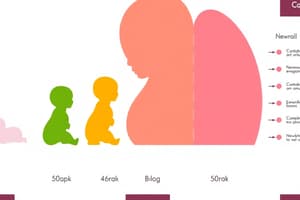Podcast
Questions and Answers
What is a common appearance of a newborn baby at birth?
What is a common appearance of a newborn baby at birth?
- Large eyes and a pointed nose
- Smooth skin with a uniform color
- Bright, vibrant skin with no hair
- Wrinkled skin covered with a waxy coating (correct)
What major physiological processes stabilize during the first fifteen days of a newborn's life?
What major physiological processes stabilize during the first fifteen days of a newborn's life?
- Urinary functions and alertness
- Hearing, taste, and mobility
- Breathing, circulation, and digestion (correct)
- Cognitive functions and vision development
Which description best fits 'random behavior' in newborns?
Which description best fits 'random behavior' in newborns?
- Planned movements in response to environmental cues
- Conscious reactions to discomfort or hunger
- Involuntary movements without clear triggering stimuli (correct)
- Involuntary muscle movements triggered by specific stimuli
What happens to a newborn's birth weight during the first two weeks?
What happens to a newborn's birth weight during the first two weeks?
What is an example of a reflex action in newborns?
What is an example of a reflex action in newborns?
Flashcards are hidden until you start studying
Study Notes
Newborn Appearance
- Newborns may appear wrinkled, red, and covered in a waxy coating.
- Their head may have thick hair, which often falls out, and their body might be covered in fine hair.
- Newborns often fall into a deep sleep after labor.
- Some newborns may experience physical difficulties and require extended recovery periods, especially if the mother's pregnancy and delivery were challenging.
The First Fifteen Days of Life
- During the first fifteen days, a newborn's breathing, circulatory system, and digestive functions stabilize.
- Newborns often lose some of their birth weight as they were retaining fat during pregnancy for support before feedings.
- They learn to suck and swallow through reflexes during these days.
Newborn Behavior
- Newborns can breathe and swallow immediately after birth.
- They can turn their heads and necks from side to side.
- They react to discomfort or restricted movements.
- Newborn behavior is categorized as follows:
- Random Behavior: Involuntary full body or part movements without a clear trigger, such as breathing, blinking, and eye opening.
- Reflex Actions: Automatic, involuntary muscle movements, such as rejecting a taste, pulling a leg after a prick, or turning their head toward a touch on their face.
Studying That Suits You
Use AI to generate personalized quizzes and flashcards to suit your learning preferences.




